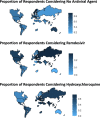International variation in the management of severe COVID-19 patients
- PMID: 32758266
- PMCID: PMC7403819
- DOI: 10.1186/s13054-020-03194-w
International variation in the management of severe COVID-19 patients
Abstract
Background: There is little evidence to support the management of severe COVID-19 patients.
Methods: To document this variation in practices, we performed an online survey (April 30-May 25, 2020) on behalf of the European Society of Intensive Care Medicine (ESICM). A case vignette was sent to ESICM members. Questions investigated practices for a previously healthy 39-year-old patient presenting with severe hypoxemia from COVID-19 infection.
Results: A total of 1132 ICU specialists (response rate 20%) from 85 countries (12 regions) responded to the survey. The survey provides information on the heterogeneity in patient's management, more particularly regarding the timing of ICU admission, the first line oxygenation strategy, optimization of management, and ventilatory settings in case of refractory hypoxemia. Practices related to antibacterial, antiviral, and anti-inflammatory therapies are also investigated.
Conclusions: There are important practice variations in the management of severe COVID-19 patients, including differences at regional and individual levels. Large outcome studies based on multinational registries are warranted.
Keywords: Acute respiratory distress syndrome; Coronavirus; Remdesivir; Viral infection.
Conflict of interest statement
The authors declare no conflict of interest in relation to this survey.
Figures




References
-
- Bauchner H, Fontanarosa PB. Randomized clinical trials and COVID-19: managing expectations. JAMA Published online May 4, 2020. doi:10.1001/jama.2020.8115. - PubMed
MeSH terms
LinkOut - more resources
Full Text Sources
Medical
Miscellaneous

